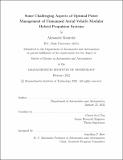Some Challenging Aspects of Optimal Power Management of Unmanned Aerial Vehicle Modular Hybrid Propulsion Systems
Author(s)
Kunycky, Alexander
DownloadThesis PDF (2.644Mb)
Advisor
Tan, Choon Sooi
Terms of use
Metadata
Show full item recordAbstract
An optimal control framework has been developed to assess the operation of an unmanned aerial vehicle (UAV) powered by a modular hybrid propulsion system (MHPS). The framework is used to assess the effects of MHPS power hybridization level and energy hybridization mass ratio on the UAV performance for two specified mission types. The results are then used to suggest selection guidelines for MHPS configurations and operational guidelines for an MHPS-powered UAV to execute various mission types with different mission requirements. Two specific mission types are selected for illustration: one, a Survey mission, consisting of climb, dash, survey, dash, and descent phases; the other, a Loiter mission, consisting of climb, dash, loiter, dash, and descent phases. Power hybridization level 𝐻ₚ refers to the percentage of propulsive power sourced from the electric motor, rather than the internal combustion engine. Energy hybridization mass ratio 𝑅ₘ refers to the percentage of energy storage system mass taken up by batteries, rather than carbon fuel. From the results of Survey mission execution optimized for minimum completion time, there are three distinct regimes defined by energy storage system (ESS) mass ratio values 𝑅ₘ₁ and 𝑅ₘ₂. MHPS configurations with 𝑅ₘ₁ ≤ 𝑅ₘ ≤ 𝑅ₘ₂ can achieve the minimum attainable mission completion time; mission completion time is longer, and total energy consumption is lower, for configurations with 𝑅ₘ < 𝑅ₘ₁ and 𝑅ₘ > 𝑅ₘ₂. From the results of Loiter mission execution optimized for minimum energy consumption, there is a distinct demarcation boundary at a threshold value of ESS mass ratio 𝑅ₘ₃ for each specific 𝐻ₚ . All UAV MHPS configurations with 𝑅ₘ ≥ 𝑅ₘ₃ will utilize the same amount of energy to complete the mission; configurations with 𝑅ₘ < 𝑅ₘ₃ require higher energy consumption to complete the same mission.
Date issued
2022-02Department
Massachusetts Institute of Technology. Department of Aeronautics and AstronauticsPublisher
Massachusetts Institute of Technology